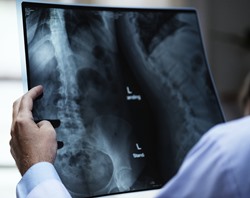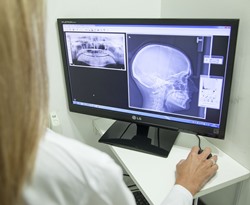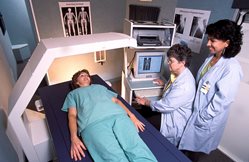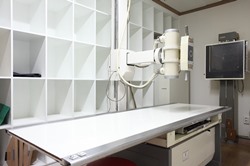How to Choose the Best X Ray Technician College near Austin Indiana
 So you have made the decision to enroll in an X-ray tech school near Austin IN so you can train to be a radiology technologist. But now that you have made a decision to go into the gratifying field of healthcare, how do you undertake picking the ideal college and program to ensure that you will get the proper training to become a skilled practitioner? And because the majority of states do require that x-ray technicians become licensed, depending on where you subsequently practice you may require preparation to pass a licensing test. So it’s imperative that you assess each of the X-ray technician schools you are looking at so that you can evaluate each program. A number of students begin by searching for colleges or technical schools that are within commuting distance of their homes. Next, they compare tuition and frequently settle on the lowest cost. But while location and cost need to be considered, there are other important qualifiers also. For instance, you must ask whether or not the radiology tech schools have earned accreditation, or if they offer internships. These inquiries and others you must ask the X-ray Tech schools you are reviewing are presented later in this post. But first, let’s talk about what a radiology technician does and the credentials and training options that are offered.
So you have made the decision to enroll in an X-ray tech school near Austin IN so you can train to be a radiology technologist. But now that you have made a decision to go into the gratifying field of healthcare, how do you undertake picking the ideal college and program to ensure that you will get the proper training to become a skilled practitioner? And because the majority of states do require that x-ray technicians become licensed, depending on where you subsequently practice you may require preparation to pass a licensing test. So it’s imperative that you assess each of the X-ray technician schools you are looking at so that you can evaluate each program. A number of students begin by searching for colleges or technical schools that are within commuting distance of their homes. Next, they compare tuition and frequently settle on the lowest cost. But while location and cost need to be considered, there are other important qualifiers also. For instance, you must ask whether or not the radiology tech schools have earned accreditation, or if they offer internships. These inquiries and others you must ask the X-ray Tech schools you are reviewing are presented later in this post. But first, let’s talk about what a radiology technician does and the credentials and training options that are offered.
X-Ray Tech Occupation Description in Austin IN
 There are multiple professional titles for x-ray techs (technologists or technicians). They can also be referred to as radiologic technicians or technologists, radiology technicians or radiographers. No matter what the name, they all have the same principal job function, which is to use imaging machines to internally visualize patients for the purpose of diagnosis and treatment. Some radiologic technologists may also provide radiation therapy for treating cancer. Many elect to work as generalists, while others may choose a specialization, for instance mammography. They may work in Austin IN clinics, hospitals, family practices or outpatient diagnostic imaging centers. The imaging technologies that an X-Ray technologist may utilize include:
There are multiple professional titles for x-ray techs (technologists or technicians). They can also be referred to as radiologic technicians or technologists, radiology technicians or radiographers. No matter what the name, they all have the same principal job function, which is to use imaging machines to internally visualize patients for the purpose of diagnosis and treatment. Some radiologic technologists may also provide radiation therapy for treating cancer. Many elect to work as generalists, while others may choose a specialization, for instance mammography. They may work in Austin IN clinics, hospitals, family practices or outpatient diagnostic imaging centers. The imaging technologies that an X-Ray technologist may utilize include:
- Traditional and specialized X-Rays
- Computerized tomography (CT) or “CAT” scans
- Magnetic resonance imaging (MRI)
- Sonography or ultrasound
- Fluoroscopy
Radiographers must care for their equipment plus regularly assess its performance and safety. They are additionally expected to retain detailed records of all of their diagnostic procedures. As health practitioners, they must adhere to a code of conduct and a high professional standard.
Click Here For Free Information on X-Ray Tech Schools Near You!
Radiology Tech Degrees Available near Austin IN
 The primary prerequisite for enrolling in a radiology tech college is to have attained a high school diploma or GED. Radiologic technologist students have the option to earn either an Associate or a Bachelor’s Degree. An Associate Degree, which is the most common among technicians, generally takes 18 months to two years to complete based upon the course load and program. A Bachelor’s Degree will take longer at up to four years to finish and is more expansive in nature. The majority of students opt for a degree major in Radiography, but there are additional related majors that are acceptable also. One thing to keep in mind is that radiographer colleges have a clinical training or lab component as part of their course of study. It can frequently be satisfied by taking part in an externship program which many colleges offer through local clinics and hospitals in Austin IN or their area. Once you have graduated from one of the degree programs, you will need to comply with any licensing or certification requirements in Indiana or the state you will be working as applicable.
The primary prerequisite for enrolling in a radiology tech college is to have attained a high school diploma or GED. Radiologic technologist students have the option to earn either an Associate or a Bachelor’s Degree. An Associate Degree, which is the most common among technicians, generally takes 18 months to two years to complete based upon the course load and program. A Bachelor’s Degree will take longer at up to four years to finish and is more expansive in nature. The majority of students opt for a degree major in Radiography, but there are additional related majors that are acceptable also. One thing to keep in mind is that radiographer colleges have a clinical training or lab component as part of their course of study. It can frequently be satisfied by taking part in an externship program which many colleges offer through local clinics and hospitals in Austin IN or their area. Once you have graduated from one of the degree programs, you will need to comply with any licensing or certification requirements in Indiana or the state you will be working as applicable.
Radiologic Technologist Licensing and Certification
After you have graduated from an Radiologist school, depending on the state where you will be working you might have to be licensed. Most states do require licensing, and their requirements differ so contact your state. Currently, all states that do mandate licensure will accept The American Registry of Radiologic Technologists (ARRT) certification exam for the licensing application, but many accept additional alternatives for testing also. A number of states also call for certification as part of the licensing process, otherwise it is optional. Having said that, numerous Austin area employers favor hiring radiology techs that have earned certification so it might enhance your career options in and around Austin IN to become certified. ARRT’s certification program calls for graduation from an approved program as well as a passing score on their comprehensive exam. ARRT also demands re-certification every two years, which may be met with 24 credits of continuing ed, or by passing an examination.
Online Radiology Technician Degrees
 As a part of any degree program, x-ray tech schools will have clinical or lab training included in their curriculum. This is no different for online degree schools. So even though you can still earn your degree online, a large amount of the training will be completed either in a school lab or in an externship off campus. Clinical training is typically provided in Austin IN hospitals, outpatient clinics or private practices in sponsorship with the schools. But the online segment of the training may be accessed in the privacy of your Austin home. Students who keep working while obtaining their degree often discover that the online approach to education is far more convenient with their active schedules. Plus online colleges are frequently less expensive than conventional alternatives. In addition to lower tuition, expenditures for study materials and commuting may be decreased as well. But just confirm that the online school you enroll in is accredited (more on the benefits of accreditation later). So if you are disciplined enough to learn with this less structured style of training, then online classes may be the ideal option for you.
As a part of any degree program, x-ray tech schools will have clinical or lab training included in their curriculum. This is no different for online degree schools. So even though you can still earn your degree online, a large amount of the training will be completed either in a school lab or in an externship off campus. Clinical training is typically provided in Austin IN hospitals, outpatient clinics or private practices in sponsorship with the schools. But the online segment of the training may be accessed in the privacy of your Austin home. Students who keep working while obtaining their degree often discover that the online approach to education is far more convenient with their active schedules. Plus online colleges are frequently less expensive than conventional alternatives. In addition to lower tuition, expenditures for study materials and commuting may be decreased as well. But just confirm that the online school you enroll in is accredited (more on the benefits of accreditation later). So if you are disciplined enough to learn with this less structured style of training, then online classes may be the ideal option for you.
What to Ask X Ray Tech Schools
Once you have chosen the kind of degree that you would like to obtain, you can initiate the process of locating and evaluating x-ray technician schools near Austin IN. You will also have to decide if you prefer to attend classes online or travel to a local campus. If you choose the latter, then of course the location of the college will be important. The cost of tuition and secondary expenditures will be a determining variable as well. But along with cost and location, what else should you consider when reviewing colleges? Well, you need to check out if the schools are accredited, and if they sponsor internship or externship programs. To help you learn some of these essential details prior to making your selection, we have compiled a list of questions that you must ask the programs you are reviewing.
Are the Radiology Technician Programs Accredited? Most xray technician colleges have acquired some type of accreditation, whether regional or national. Even so, it’s still imperative to confirm that the school and program are accredited. One of the most highly regarded accrediting agencies in the field of radiology is the Joint Review Committee on Education in Radiologic Technology (JRCERT). Schools obtaining accreditation from the JRCERT have gone through an extensive review of their instructors and educational materials. If the college is online it can also earn accreditation from the Distance Education and Training Council, which focuses on distance or online education. All accrediting agencies should be acknowledged by the U.S. Department of Education or the Council on Higher Education Accreditation. In addition to guaranteeing a quality education, accreditation will also assist in acquiring financial assistance and student loans, which are frequently not available for non-accredited schools. Accreditation might also be a pre-requisite for licensing and certification as required. And many Austin IN health facilities will only hire a graduate of an accredited college for entry level openings.
Are Internship Programs Provided? Ask if the xray technician programs you are reviewing have relationships with area clinics or hospitals for internship programs. Internships are not only a great means to obtain practical experience in a clinical setting, they are additionally a means to satisfy the practical training requirement for most programs. As an ancillary benefit, they can help graduates and students form professional relationships in the Austin IN healthcare community and assist with job placement.
Is Job Placement Assistance provided? You will undoubtedly wish to hit the ground running after graduating, but finding that first job in Austin IN in a new field can be challenging without support. Find out if the radiographer schools you are considering have job placement programs and what their success rates are. High and rapid placement rates are an excellent indication that the schools have sizable networks and great relationships with Indiana healthcare employers. It also corroborates that their graduates are highly regarded and sought after.
Where is the Program Located? For a number of students, the school they pick will have to be within driving distance of their Austin IN home. Those who have chosen to attend online classes naturally will not have to concern themselves with the location of the campus. However, the availability of area internships will be of importance. Something to bear in mind is that if you choose to enroll in a program that is out of state or even out of your local area, you may have to pay a higher tuition. State colleges typically charge higher tuitions for out of state residents. And community colleges often charge a higher tuition to those students that live outside of their districts.
What are the Class Sizes ? Unless you are the type of student that prefers to sit far in the rear of the classroom or hide in the crowd, you will undoubtedly prefer a small class size. Smaller classes allow for more individual participation and personalized instruction. Ask the Austin IN colleges you are researching what the average student to teacher ratio is for their classrooms. If practical you may want to monitor one or more classes before making your ultimate determination. This will also give you an opportunity to converse with a few of the instructors and students to get their perspectives regarding the radiology technician program also.
Does the Program Accommodate your Schedule? And last you need to confirm that the xray tech school you ultimately pick can offer the class schedule you need. This is particularly crucial if you opt to continue working while you attend school. If you need to schedule evening or weekend classes in the Austin IN area, verify that they are offered. If you can only enroll on a part-time basis, check if that is an option and how many credit hours or courses you would need to enroll in. Also, ask what the procedure is for making up any classes that you might miss because of work, illness or family emergencies.
Low Cost Part Time Radiologic Tech Schools Austin IN
 Choosing the ideal x-ray tech school is a critical first step toward beginning a fulfilling new career furnishing diagnostic medical services to patients. The ideal radiologic technologist must be in good physical condition. X-Ray techs frequently stand for the greater part of the working day and move and at times lift the patient to get the correct image. Prospects must also demonstrate a capability to pay close attention to detail and to observe the safety guidelines developed to protect both the patient and the medical team. X-Ray techs work very closely with patients, other techs as well as the doctors and radiologists. Having social skills is a must in order to have a productive work environment and deliver the best possible care to patients. You originally came to this website due to an interest in Low Cost Part Time Radiologic Tech Schools and wanting more information on the topic How to Enroll in Accredited Schools For X Ray Techs. However, as has been discussed in this article, there are a number of questions that you need to ask each college you are assessing prior to making your final decision. This is similarly true whether you opt for an online school or drive to classes on-campus. By asking the appropriate questions you can assess and compare each college so you can focus your choices and make your final choice. And with the appropriate education and your commitment to succeed, you can reach your goal to practice as a radiologic technologist in Austin IN.
Choosing the ideal x-ray tech school is a critical first step toward beginning a fulfilling new career furnishing diagnostic medical services to patients. The ideal radiologic technologist must be in good physical condition. X-Ray techs frequently stand for the greater part of the working day and move and at times lift the patient to get the correct image. Prospects must also demonstrate a capability to pay close attention to detail and to observe the safety guidelines developed to protect both the patient and the medical team. X-Ray techs work very closely with patients, other techs as well as the doctors and radiologists. Having social skills is a must in order to have a productive work environment and deliver the best possible care to patients. You originally came to this website due to an interest in Low Cost Part Time Radiologic Tech Schools and wanting more information on the topic How to Enroll in Accredited Schools For X Ray Techs. However, as has been discussed in this article, there are a number of questions that you need to ask each college you are assessing prior to making your final decision. This is similarly true whether you opt for an online school or drive to classes on-campus. By asking the appropriate questions you can assess and compare each college so you can focus your choices and make your final choice. And with the appropriate education and your commitment to succeed, you can reach your goal to practice as a radiologic technologist in Austin IN.
Other Indiana Diagnostic Locations
Austin, Texas
Austin (UK: /ˈɒstɪn, ˈɔːstɪn/, US: /ˈɔːstən/)[5] is the capital city of the U.S. state of Texas and the seat of Travis County, with portions extending into Hays and Williamson counties. It is the 11th-most populous city in the United States, the fourth-most-populous city in Texas, and the second-most-populous state capital city (after Phoenix, Arizona).[6] It is also the fastest growing large city in the United States[7][8] and the southernmost state capital in the contiguous United States. As of the U.S. Census Bureau's July 1, 2018 estimate, Austin had a population of 964,254[9] up from 790,491 at the 2010 census.[3] The city is the cultural and economic center of the Austin–Round Rock metropolitan statistical area, which had an estimated population of 2,168,316 as of July 1, 2018[update]. Located in Central Texas within the greater Texas Hill Country, it is home to numerous lakes, rivers, and waterways, including Lady Bird Lake and Lake Travis on the Colorado River, Barton Springs, McKinney Falls, and Lake Walter E. Long.
In the 1830s, pioneers began to settle the area in central Austin along the Colorado River. In 1839, the site was chosen to replace Houston as the capital of the Republic of Texas and was incorporated under the name "Waterloo". Shortly afterward, the name was changed to Austin in honor of Stephen F. Austin, the "Father of Texas" and the republic's first secretary of state. The city grew throughout the 19th century and became a center for government and education with the construction of the Texas State Capitol and the University of Texas at Austin.[10] After a severe lull in economic growth from the Great Depression, Austin resumed its steady development, and by the 1990s it emerged as a center for technology and business.[11] A number of Fortune 500 companies have headquarters or regional offices in Austin including, 3M, Amazon.com, Apple Inc., Cisco, eBay, General Motors, Google, IBM, Intel, Oracle Corporation, PayPal, Texas Instruments, and Whole Foods Market.[12]Dell's worldwide headquarters is located in the nearby suburb of Round Rock.
Residents of Austin are known as Austinites.[13] They include a diverse mix of government employees, college students, musicians, high-tech workers, blue-collar workers, and a vibrant LGBT community.[14] The city's official slogan promotes Austin as "The Live Music Capital of the World," a reference to the city's many musicians and live music venues, as well as the long-running PBS TV concert series Austin City Limits.[15][16] The city also adopted "Silicon Hills" as a nickname in the 1990s due to a rapid influx of technology and development companies. In recent years, some Austinites have adopted the unofficial slogan "Keep Austin Weird,"[17] which refers to the desire to protect small, unique, and local businesses from being overrun by large corporations.[18] In the late 19th century, Austin was known as the "City of the Violet Crown," because of the colorful glow of light across the hills just after sunset.[19] Even today, many Austin businesses use the term "Violet Crown" in their name. Austin is known as a "clean-air city" for its stringent no-smoking ordinances that apply to all public places and buildings, including restaurants and bars.[20]
